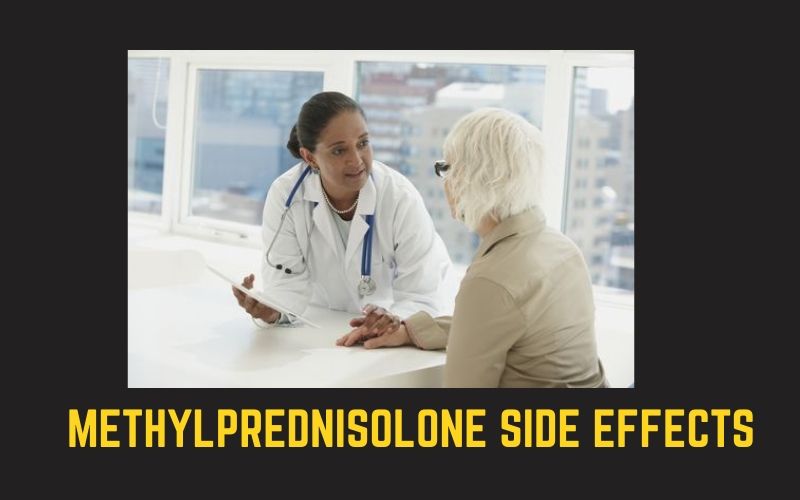Methylprednisolone is a drug used in a wide range of diseases characterized by inflammatory states. It is indicated in the case of endocrine disorders such as adrenal insufficiency (deficiency of three classes of hormones produced by the adrenal gland), inflammations of the thyroid gland, or hypercalcemia caused by neoplasms and also used in the case of rheumatological diseases such as juvenile idiopathic arthritis, psoriatic arthritis, collagenopathies, and systemic lupus erythematosus. It is also used in the therapy of lymphomas and leukemias, to induce diuresis in nephrotic syndrome (a disease characterized by renal damage) and in some diseases involving red blood cells such as hemolytic anemia and platelets such as immune thrombocytopenia. In this article, we describe what the side effects of methylprednisolone Steroid & others about methylprednisolone are. Make Small Room Spacious
Table of Contents
SIDE EFFECTS
The severity and frequency of side effects depend on the size of the dose and duration of use.
Metabolism: sodium and water retention, negative nitrogen balance, edema, hypokalemic alkalosis, potassium loss, weight gain.
Endocrine system
Atrophy of the adrenal cortex, Itsenko-Cushing’s syndrome, hypothalamic-pituitary insufficiency (especially in stressful situations, such as trauma, illness, surgery), steroid diabetes, decreased carbohydrate tolerance, increased need for oral hypoglycemic drugs and insulin in patients with diabetes mellitus, menstrual irregularities, impotence, glucosuria, hirsutism, growth retardation in children.
Digestive system
Bloating, nausea, peptic ulcer with possible perforation and bleeding, ulcerative esophagitis, vomiting, pancreatitis.
Cardiovascular system and blood (hematopoiesis, hemostasis)
congestive heart failure (in predisposed patients), arterial hypertension, thrombophilia, arrhythmia. There reports of the development of vascular insufficiency. Bradycardia was noted during or after the administration of high doses of methylprednisolone Steroid sodium succinate (no relation to the rate and duration of administration was determined).
Nervous system and sensory organs
dizziness, headache, pseudotumor of the brain, increased intracranial pressure, convulsions, mental disorders, increased intraocular pressure, exophthalmos.
Musculoskeletal system
steroid myopathy, muscle weakness, decreased muscle mass, osteoporosis (especially in children and women), compression fractures of the vertebrae, pathological fractures of the long bones, aseptic necrosis of the femoral and hummers heads, tendon ruptures, primarily Achilles.
Allergic reactions
anaphylactic shock, urticaria, bronchospasm.
Skin
Impaired regeneration, atrophy and thinning of the epidermis, subcutaneous tissue, dermis, petechiae, slow healing of wounds, striae, pyoderma, steroid acne, candidiasis, ecchymosis, hypo- and hyperpigmentation.
Other
Decreased resistance to infection. Reactions at the injection site: numbness, burning, pain, infection at the injection site, paresthesia, scarring at the injection site, hyper- or hypopigmentation, sterile abscess, atrophy of the skin and subcutaneous tissue.
FARM AUCTION
Methylprednisolone is a synthetic glucocorticosteroid. Methylprednisolone in the cell cytoplasm reacts with specific receptors. As a result, a kit is formed that enters. The cells nucleus and causes depression of messenger RNA. And changes the synthesis of proteins on the ribosomes that mediate cellular effects. The anti-inflammatory effect of methylprednisolone Steroid is due to an increase in the formation of lipocortin’s, which inhibits phospholipase A2 and slows the release of arachidonic acid from membrane phospholipids with further inhibition of the production of leukotrienes, cyclic endoperoxides, prostaglandins, hydroxy acids, thromboxane.
And
Methylprednisolone acts on all phases of inflammation. By stabilizing the lysosome membranes, methylprednisolone Steroid reduces the output of their enzymes, inhibits the production of hyaluronidase, improves microcirculation, reduces the formation of inflammatory exudate and the permeability of capillaries, inhibits the synthesis of lymphokines (gamma-interferon, interleukin 1 and 2) in macrophages and lymphocytes, slows down the transition of macrophages, infiltration, and granulation, reduces the formation of mucopolysaccharides and collagen, suppresses the liberalization of eosinophils and inflammatory mediators.
Also
Methylprednisolone has a minor mineral corticosteroid activity. Reduces production and increases protein breakdown in muscles, increases the synthesis of triglycerides. And higher fatty acids stimulates gluconeogenesis, cause hyperglycemia and redistribution of fat, increase the level of glycogen. In muscles and liver disrupts bone mineralization.
In medicine, methylprednisolone (tablet form). Methylprednisolone sodium succinate (for intramuscular and intravenous administration). Methylprednisolone acetate (for intramuscular, periarticular, intraarticular, intra-bursal administration.
INDICATIONS
For systemic use (inside and parenteral). Endocrine diseases: primary or secondary adrenocortical insufficiency (the drug of choice is cortisone or hydrocortisone; if necessary, synthetic analogs can be used together with mineralocorticoids; mineralocorticoids are important in pediatric practice), hypercalcemia in malignant neoplasms, non-purulent thyroiditis, congenital hyperplasia; respiratory system diseases: berylliosis, symptomatic sarcoidosis, disseminated or fulminant pulmonary tuberculosis together with appropriate anti-tuberculosis treatment, Leffler’s syndrome not amenable to treatment with other drugs, aspiration pneumonia, lung cancer (along with cytostatic); edematous syndrome (to stimulate diuresis or achieve regression of proteinuria in patients with a nephrotic syndrome without uremia, caused by systemic lupus erythematosus.
In which the usual treatment is ineffective): serum sickness, seasonal or perennial allergic rhinitis, hypersensitivity reactions to drugs, contact dermatitis, bronchial asthma, atopic dermatitis; eye diseases (chronic inflammatory and allergic and severe acute processes with eye damage): ophthalmia caused by herpes zoster, allergic corneal ulcers, anterior segment inflammation, sympathetic ophthalmia, diffuse posterior uveitis and choroiditis, allergic conjunctivitis, chorioretinitis, keratitis, neuritis, iridocyclitis, iritis. In which the usual treatment is ineffective): serum sickness, seasonal or perennial allergic rhinitis, hypersensitivity reactions to drugs, contact dermatitis, bronchial asthma, atopic dermatitis; eye diseases (chronic inflammatory and allergic and severe acute processes with eye damage): ophthalmia caused by herpes zoster, allergic corneal ulcers, anterior segment inflammation, sympathetic ophthalmia, diffuse posterior uveitis and choroiditis, allergic conjunctivitis, chorioretinitis, keratitis, neuritis, iridocyclitis, iritis.
CONTRAINDICATIONS
Hypersensitivity
For methylprednisolone when used systemically: chronic and acute viral or bacterial diseases, HIV or AIDS, systemic fungal infections, latent and active tuberculosis (without appropriate treatment), arterial hypertension, congestive heart failure, severe renal and / or liver dysfunction, recent myocardial infarction (possibly slowing down the formation of scar tissue, spreading the focus of necrosis, rupture of the heart muscle), intestinal anastomosis (in the near history), gastritis, esophagitis, latent or acute peptic ulcer, myasthenia gravis, diabetes mellitus, glaucoma, hypothyroidism, severe osteoporosis, mental disorders, lymphomas after BCG vaccination, poliomyelitis (except for bulbar-encephalic forms), vaccination period.
DOSAGE
Methylprednisolone Steroid is taken orally. Injected (intravenously, intramuscularly, into the synovial bags and vagina, epidurally. Into the area of skin lesions, into the joint cavity) and rectally. The dosage regimen and route of administration. Set depending on the severity and nature of the disease. The condition of the patient, age, response to ongoing therapy.
Insideadults
4 to 60 mg per day in divided doses or once; as a rule, the initial dose is 4 to 48 mg per day. In some cases, up to 100 mg per day, the maintenance dose is 4 to 12 mg per day. Children: adrenal insufficiency: inside 4 mg / m2 or 0.14 mg / kg per day in 3 doses, intramuscularly – the same dose after two days or 0.039 – 0.0585 mg / kg per day every day; according to other indications: by mouth 12.5-50 mg / m2 or 0.417-1.67 mg / kg in three divided doses, intramuscularly 4.16-25 mg / m2 or 0.139-0.835 mg / kg every 12-24 hours.
Intramuscularly, in the form of a suspension (depot form) for adults:
40 – 120 mg for 1 to 4 weeks. If with the pathology to which the treatment is directed. Additional symptoms of stress develop. Then the dose of the suspension should be increased. If it is necessary to obtain the maximum and fastest effect of hormone therapy. Intravenous administration of methylprednisolone Steroid sodium succinate is indicated.
Intravenously (“pulse therapy”), 30 mg/kg of methylprednisolone succinate is administered for 0.5 hours. If necessary, repeatedly every 6 hours.
In synovial bags and vagina, intraarticular – 20-60 mg, epidurally – up to 80 mg, in the abdominal and pleural cavity – up to 100 mg, in the area of skin lesions – 20-60 mg.
In the case of
Ulcerative colitis with a retaining enema. 40 to 120 mg is administered to relieve nausea and vomiting: adults – 250 mg 20 minutes before and 6 hours after taking cytostatic—children – at least 25 mg per day. In the event of spontaneous remission, therapy is stopped.
Since
In addition, the complications of treatment with glucocorticoids depend on the dose used. And the duration of therapy. In each case, it is necessary to compare the ratio of benefit and risk to decide on treatment with glucocorticoids—the duration of therapy, and the dosage regimen.
In other words, long-term use of glucocorticoids can cause the development of glaucoma—posterior subcapsular cataract with possible damage to the optic nerve. So, an increase in the frequency of development of secondary fungal or viral infections of the eyes is possible.
After corticosteroid therapy, an increase in the content of alkaline phosphatase. Alanine aminotransferase. Are insignificant and reversible after discontinuation of treatment.
The patient appears (especially with the appearance of a depressive state, suicidal thoughts), it is necessary to seek medical help.
Due to the possibility of developing visual impairment. Dizziness and weakness when using methylprednisolone.
INTERACTION
Phenobarbital, phenytoin, diphenhydramine, rifampicin, and other inducers of liver enzymes. Increase the excretion rate and decrease. So, the therapeutic efficacy of methylprednisolone (a dose change may be required). In other words, Oleandomycin, itraconazole, ketoconazole, oral estrogen-containing contraceptives, diltiazem, grapefruit juice, and other liver enzyme inhibitors can inhibit the metabolism of methylprednisolone. So, increase its half-life, reduce its clearance. And increase toxic and therapeutic effects. Substrates of hepatic enzymes can affect—the pharmacokinetic parameters of methylprednisolone.
So, the simultaneous use of methylprednisolone and cyclosporine mutually slows down the metabolism. And increases the risk of adverse reactions (there have been cases of seizures). Methylprednisolone can increase the clearance of acetylsalicylic acid. This has been used in high doses for a long time. As a result, its concentration in the blood may decrease (after discontinuation of methylprednisolone, the content of acetylsalicylic acid in the blood increases, and the risk of its side effects increases). It is necessary to use acetylsalicylic acid with corticosteroids in patients with hypoprothrombinemia with caution.
And
When combined with methylprednisolone Steroid and paracetamol. It increases the risk of hepatotoxicity (due to the induction of liver enzymes and the formation of a toxic metabolite of paracetamol). Methylprednisolone acts on oral anticoagulants. Both a decrease and an increase in the effect of anticoagulants are possible.
Firstly, the action of methylprednisolone enhances adrenocorticotropic hormone. High doses of methylprednisolone reduce the effectiveness of the growth hormone. So, Parathyroid hormone and ergocalciferol inhibit osteopathy—however, alcohol, non-steroidal anti-inflammatory drugs. In addition, including salicylates, indomethacin, phenylbutazone, antacids (slow down absorption) increase the risk of ulceration of the gastric mucosa. And they are bleeding, cardiac glycosides – arrhythmias, carbonic anhydrase inhibitors, and amphotericin B – hypokalemia, cardiac hypertension, heart failure. So, mitotane and other inhibitors of adrenal cortex function may necessitate an increase in the dose of methylprednisolone. Methylprednisolone reduces the effectiveness of vaccines (against the background of methylprednisolone, Live vaccines can cause disease). So, the activity of oral antidiabetic drugs. However, androgens, in combination with methylprednisolone, increase the risk of edema. Methylprednisolone accelerates the metabolism of mexiletine. FEATURES AND OVERVIEWS OF JAHAANM TV
SPECIAL INSTRUCTIONS
Pregnancy and lactation
The use of corticosteroids during pregnancy is possible. So, if the intended effect of treatment exceeds. However, the possible risk to the fetus (no strictly controlled and adequate safety studies have been conducted). So, It is necessary to warn women of childbearing age about a possible risk to the fetus (corticosteroids cross the placenta)—careful monitoring of newborns. Mothers took corticosteroids during pregnancy (there is a risk of developing adrenal insufficiency in the newborn, and the fetus) is necessary. Do not use it in large doses. Often over an extended period. Nursing women should stop breastfeeding or use the drug. So, It can inhibit the formation of endogenous corticosteroids.
Overdose
With an overdose of methylprednisolone. The following symptoms develop: edema, decreased filtration, the appearance of protein in the urine, arterial hypertension, cardiopathy, arrhythmias, hypokalemia. So, repeated frequent use of methylprednisolone Steroid(every day or several times a week).In other words, for an extended period can lead to the development of Itsenko-Cushing’s syndrome. In which drug withdrawal is necessary. However, treatment: symptomatic, forced diuresis, potassium chloride, psychosis, and depression: drug withdrawal or dose reduction and administration of lithium salts or phenothiazine drugs.





